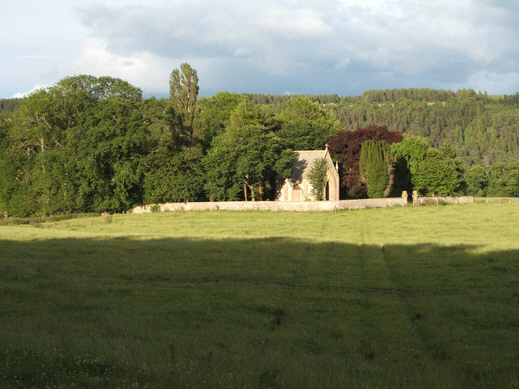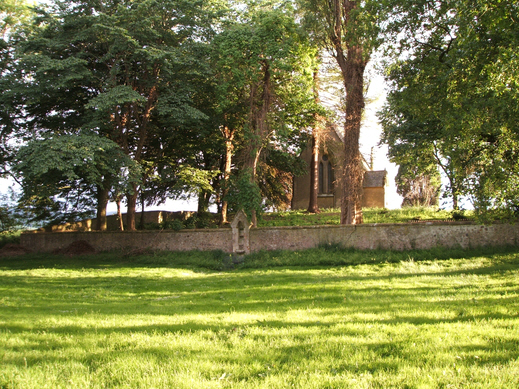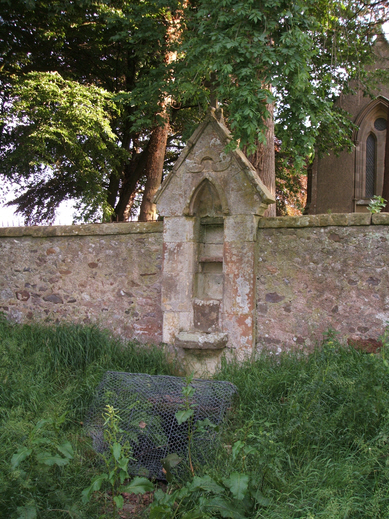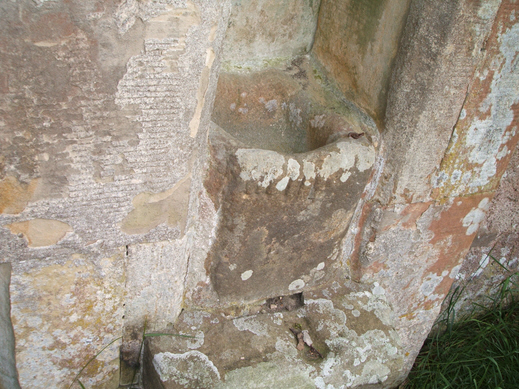Elgin Deanery
Chapel of Mary at Orton
Lady Mary of Grace Well
Chapel: OS Ref: NGR NJ 302510 H.E.S. No: NJ35SW 4 Dedication: Mary of Grace
The Chapel of Mary of Grace at Orton is a site of considerable antiquity and has been made famous in northern Scotland because of the Holy Well that, to this day, flows beside it. The well itself was the popular resort for those who wished a cure from its waters and was renowned across the north and east of the country for its curative powers. Many flocked to the location on the first Sunday in May every year, even long after the days of the Roman Catholic Church had passed and, as we shall see, there are numerous entries in the parish records of churches up and down the country, condemning in no uncertain terms those who were drawn by its superstitious powers.
The Well itself is no mystery - it is a simple 'chalybeate spring' - although its location on the Haugh, at virtually the same elevation as the nearby river, is rather more remarkable. The water from a Chalybeate source is impregnated with salts of iron. For generations, that at Orton has been valued for both human and animal treatments and there are many tales from across the country of miraculous cures - of mange in horses, scrofula and ague in humans, etc.. Another most famous source of chalybeate water is that at Dorton Spa in Buckinghamshire, where mangy dogs and disesed cattle received cures from being washed in the water. Cheltenham Spa is another renowned chalybeate source as is the Dog Well at Malvern and the Holy Well that was within the bounds of Malvern Priory.1 More locally, there were chalybeate springs at Rothes (the Minister's Well or St Lawrence's Well)
Robertson wrote as late as 1891 that, "For more than half a century, the Kirk continued to launch her thunders against pilgrimages to some of the more famous shrines; and even so lately as 1775 the historian of Murray complained that, to 'the chapel of Our Lady of Grace' on the Spey, multitudes, even from the Western Isles, do still resort, and nothing short of violence can restrain their superstition. So obstinately did the ancient rites linger in the affection of the people, that the Parliament in 1581 had to forbid, by severe penalties, pilgrimages to chapels, wells, and crosses, church-wakes and holidays, singing of carols and lighting of bonfires."2 What a wonderful thing the Second Reformation was!


the retaining wall of the mausoleum.
At Orton, there are said to have been several containers each used for the administration of a different 'cure', but, in each case, it was said that to derive any benefit the pilgrim had to turn the container(s) they were about to use "thrice withershins" - three times counter-clockwise or against the sun - an obvious remnant of a more pagan history, which, as we shall see, allowed post-Reformation ministers to regale their congregations about superstitious practices.
What is most remarkable about the Lady Grace Well is not its great antiquity, but its utter resillience when faced with assaults from all sides as a consequence of the Second Reformation of 1560. For generations after the supposed removal of 'Popery' we can find numerous references in various presbytery and parish minutes, recounting the continuing superstitious habits of their congregations in going to "the well at Speyside." Robert Chambers remarks: "One of the chief places in vogue was the Chapel of Grace, on the western bank of the Spey, near Fochabers - a mere ruin, but held in great veneration, and resorted to by devout people from all parts of the north of Scotland. We hear of Lady Aboyne going to the chapel of Grace every year, being a journey of thirty Scotch miles, the last two of which she always performed on her bare feet. About the time of the National Covenant (1638), what remained of the Chapel of Grace was thrown down, with a view to putting a stop to the practice; but this seems to have been far from an effectual measure."3


Certain modern writers deny that there ever was a medieval chapel on this site.4 However, I believe that the evidence rests in favour of the older writers and the parish/presbytery records - both make repeated reference to a well
Quo primum loco Moraviensis Christiani
Sacellum Mariae Virginis in honorem posuerunt
hoc Mausoleum ut sub ejus tecto Reliquae
Sui ipsus Suorom que
Requiescant in Pace.
Sepulchri Memor Extruendum Curavit
Ricardus Wharton Duff de Orton
Armiger.
Anno Salutis 1844.
1664 (14 September) Janett Rin, in the parish of St Andrews, compeirs for superstitiously going to Ladie Grace well and other offences. She acknowledged going to the well.6
1663 (16 August) The minister represented to the eldership, "that it was heavily regrated by the ministers of the presbyterie that some people of their parishes went superstitiously to a place at Speyside called the Chappell of Grace therefore it is recommended to the elders to try if anie of the inhabitants of this parish goe thither and to make report the next day." 7
1670 (25 September) Margaret Bannerman and three other women are reproved before the congregation for their superstitious going to the Chappell of Grace.8
1705 (20 August) "The session taking to their serious consideration that severall persons in this paroch were reported to be guilty of a superstitious custome of goeing yearly to a well at Speyside, recommended it to the minister to consult the presbytery thereanet."9
1705 (29 October) The presbytery resolve to do their utmost to repress the superstitious practice of going to the well of Spey.10
1664 (16 October) "Compeired Janet Ragge, Isobell Ragge, Margaret Feld, Agnes Mitchell, and Isobell Naughtie, who were all summoned to answer for superstitious repairing to the chappell well at Speyside who all after examinatione wer convinced to confess their goeing thither. They wer therfor rebuked and ordained to public repentance a day in sackcloth."11
1665 (24 September) "Margaret Anderson, Elspet Davidson, and Isobell Russell, to stand a day at the pillar and to be rebuked before the congregation for superstitious going to the chappell well at Spey."12
1636 (14 September) "Peter Wat, summoned to this day for goeing in pilgrimage to the chappell beyond the water of Spey, compeared and confessed his fault. Ordained to make his repentance, and to pay four markes penaltye."
"Agnes Jack sumoned to this day for goeing in pilgriage to the same chappell, compeared, and confessed that she went to the said chappell with ane diseased woman, but gave her great oath that she used no kynd of superstitious worship. She is ordained to mak he publike repentance, and to abstaine from the lyke in tyme comeing."13
1. Iron waters (also known as ferruginous waters) are characteristically unstable once they come into contact with air so are not suited to bottling or storage. The water has to be drunk at source. It was reputedly good for worms, colic, the melancholy and enriching the blood; it was suitable in the treatment of 'vapours', killed flatworms in the belly, and could make the fat lean and the lean fat. [Addison, W. (1951) English Spas, London: Batsford, p. 22.] Return
2. Robertson, Joseph (1891) Scottish Abbeys and Cathedrals, Aberdeen: Wylie, p. 89. Return
3. Chambers, Robert (1861) Domestic Annals of Scotland: from the Revolution to the Rebellion of 1745, Edinburgh: Chambers, p. 325. Return
4. POWiS Database (Places of Worship in Scotland) states that, "an examination of the site in the 1970s found no evidence of any structure, remains or burial earlier than the 1840s when the mausoleum was built. The burial enclosure is private and still in use and so was not visited.
5. Shaw, L. (1882) The History of the Province of Moray, Vol 1, Glasgow, pp. 85-86, note at foot of p. 86. Return
6. Presbytery Minutes of St Andrews.
7. Cramond, Wm. (1900) The Church of Alves - Kirk Session Minutes, Elgin: Courant & Courier, p.45.
8. ibid., p. 50.
9. ibid., p. 70.
10. ibid., p. 71.
11. Cramond, Wm. (1899?) The Church & Priory of Urquhart, Elgin: Courant & Courier, p. 48.
12. ibid., p.50.
13. Stuart, John (1843) Extracts from the Presbytery Book of Strathbogie, A.D. MDCXXXI-MDCLIV, Aberdeen: Spalding Club, p.8; Mackinlay, J.M. (1910) Ancient Church Dedications in Scotland: Scriptural Dedications, Edinburgh: David Douglas, p. 113.
e-mail: admin@cushnieent.com
© 2019 Cushnie Enterprises

